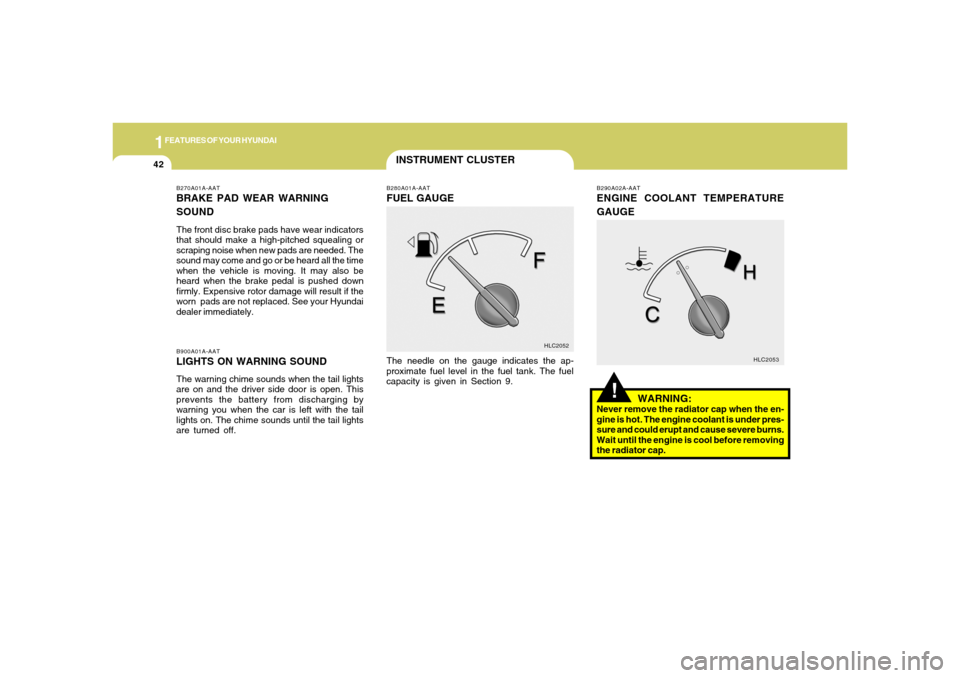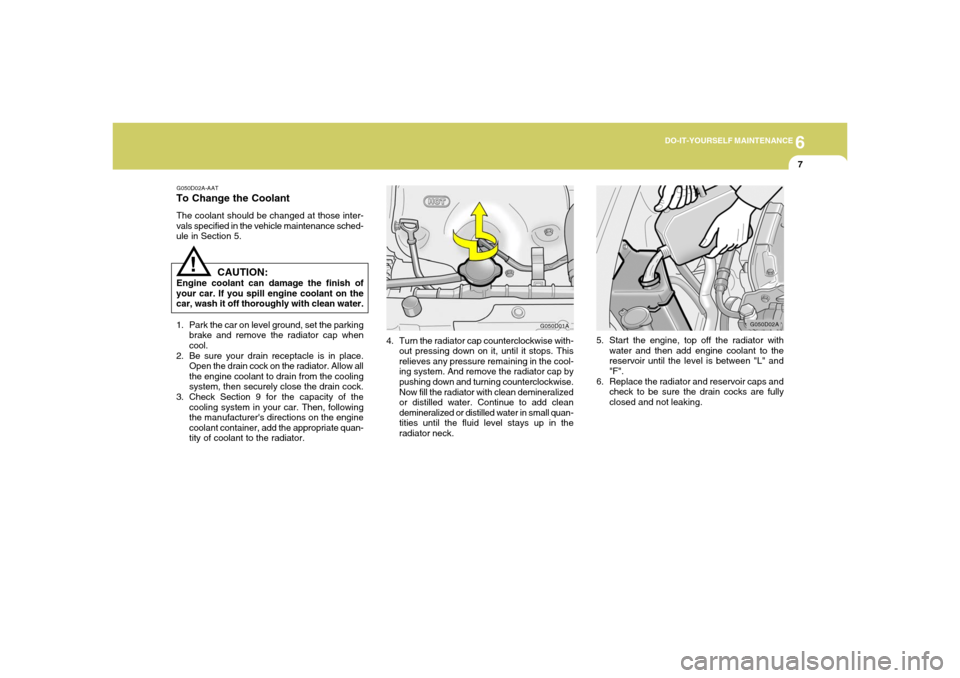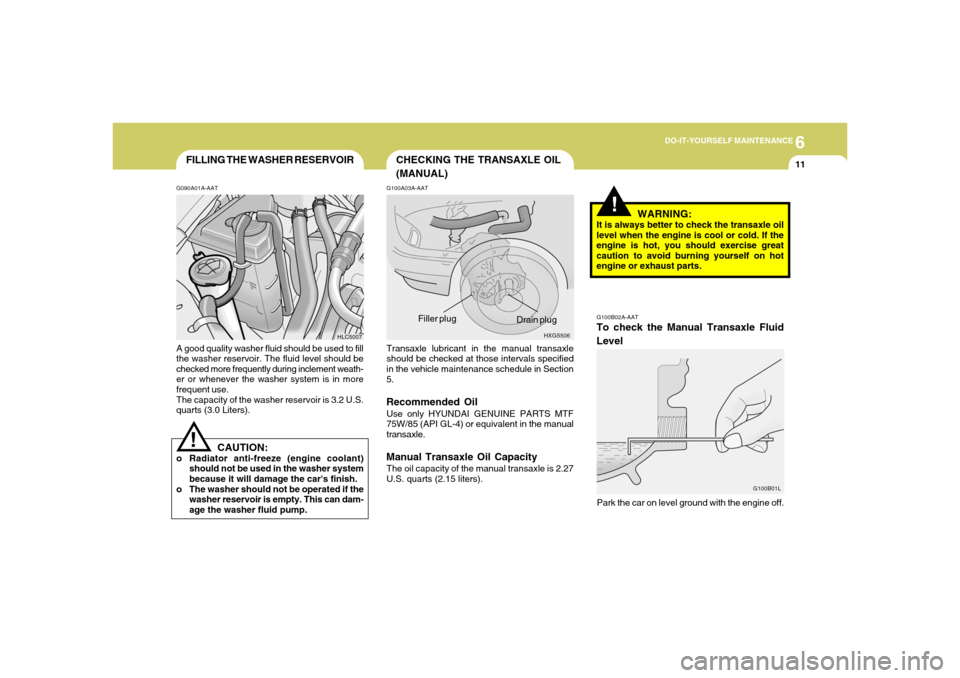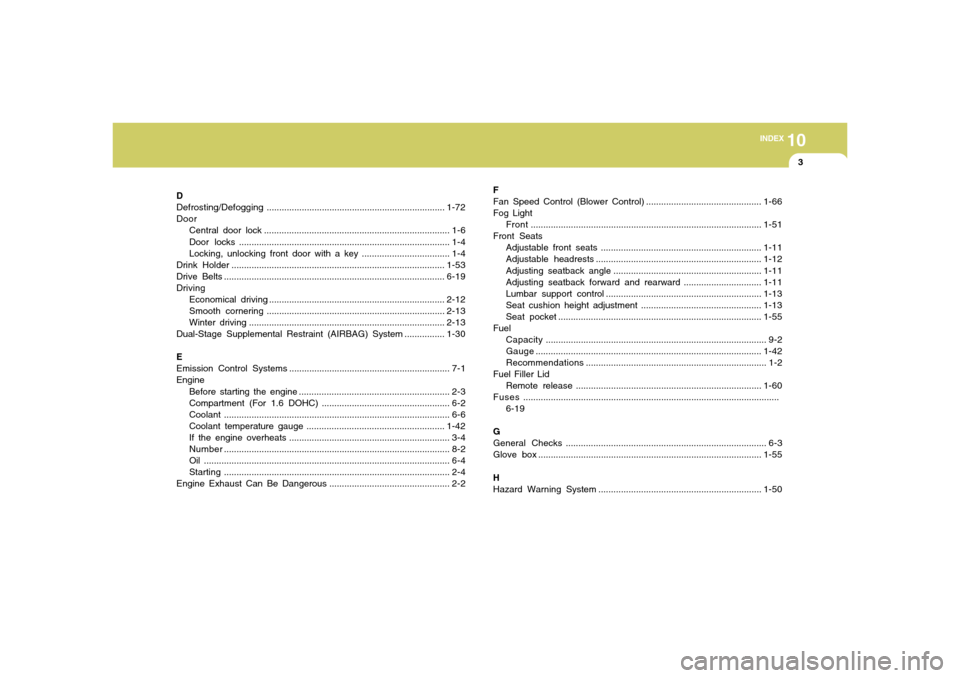coolant capacity Hyundai Accent 2005 Owner's Manual
[x] Cancel search | Manufacturer: HYUNDAI, Model Year: 2005, Model line: Accent, Model: Hyundai Accent 2005Pages: 219, PDF Size: 7.07 MB
Page 54 of 219

1FEATURES OF YOUR HYUNDAI42
INSTRUMENT CLUSTER
B270A01A-AATBRAKE PAD WEAR WARNING
SOUNDThe front disc brake pads have wear indicators
that should make a high-pitched squealing or
scraping noise when new pads are needed. The
sound may come and go or be heard all the time
when the vehicle is moving. It may also be
heard when the brake pedal is pushed down
firmly. Expensive rotor damage will result if the
worn pads are not replaced. See your Hyundai
dealer immediately.B900A01A-AATLIGHTS ON WARNING SOUNDThe warning chime sounds when the tail lights
are on and the driver side door is open. This
prevents the battery from discharging by
warning you when the car is left with the tail
lights on. The chime sounds until the tail lights
are turned off.
B280A01A-AATFUEL GAUGEThe needle on the gauge indicates the ap-
proximate fuel level in the fuel tank. The fuel
capacity is given in Section 9.
HLC2052
!
B290A02A-AATENGINE COOLANT TEMPERATURE
GAUGE
WARNING:Never remove the radiator cap when the en-
gine is hot. The engine coolant is under pres-
sure and could erupt and cause severe burns.
Wait until the engine is cool before removing
the radiator cap.
HLC2053
Page 162 of 219

6
DO-IT-YOURSELF MAINTENANCE
7
G050D02A-AATTo Change the CoolantThe coolant should be changed at those inter-
vals specified in the vehicle maintenance sched-
ule in Section 5.
CAUTION:
Engine coolant can damage the finish of
your car. If you spill engine coolant on the
car, wash it off thoroughly with clean water.
1. Park the car on level ground, set the parking
brake and remove the radiator cap when
cool.
2. Be sure your drain receptacle is in place.
Open the drain cock on the radiator. Allow all
the engine coolant to drain from the cooling
system, then securely close the drain cock.
3. Check Section 9 for the capacity of the
cooling system in your car. Then, following
the manufacturer's directions on the engine
coolant container, add the appropriate quan-
tity of coolant to the radiator.
!
4. Turn the radiator cap counterclockwise with-
out pressing down on it, until it stops. This
relieves any pressure remaining in the cool-
ing system. And remove the radiator cap by
pushing down and turning counterclockwise.
Now fill the radiator with clean demineralized
or distilled water. Continue to add clean
demineralized or distilled water in small quan-
tities until the fluid level stays up in the
radiator neck.
G050D01AG050D02A
5. Start the engine, top off the radiator with
water and then add engine coolant to the
reservoir until the level is between "L" and
"F".
6. Replace the radiator and reservoir caps and
check to be sure the drain cocks are fully
closed and not leaking.
Page 166 of 219

6
DO-IT-YOURSELF MAINTENANCE
11
CHECKING THE TRANSAXLE OIL
(MANUAL)
FILLING THE WASHER RESERVOIRG090A01A-AATA good quality washer fluid should be used to fill
the washer reservoir. The fluid level should be
checked more frequently during inclement weath-
er or whenever the washer system is in more
frequent use.
The capacity of the washer reservoir is 3.2 U.S.
quarts (3.0 Liters).
CAUTION:
o Radiator anti-freeze (engine coolant)
should not be used in the washer system
because it will damage the car's finish.
o The washer should not be operated if the
washer reservoir is empty. This can dam-
age the washer fluid pump.
!
G100A03A-AATTransaxle lubricant in the manual transaxle
should be checked at those intervals specified
in the vehicle maintenance schedule in Section
5.Recommended OilUse only HYUNDAI GENUINE PARTS MTF
75W/85 (API GL-4) or equivalent in the manual
transaxle.Manual Transaxle Oil CapacityThe oil capacity of the manual transaxle is 2.27
U.S. quarts (2.15 liters).
HLC5007HXGS506
Drain plug Filler plug
!
WARNING:
It is always better to check the transaxle oil
level when the engine is cool or cold. If the
engine is hot, you should exercise great
caution to avoid burning yourself on hot
engine or exhaust parts.G100B02A-AATTo check the Manual Transaxle Fluid
LevelPark the car on level ground with the engine off.
G100B01L
Page 199 of 219

8
CONSUMER INFORMATION, REPORTING SAFETY DEFECTS & BINDING ARBITRATION OF WARRANTY CLAIMS
7
6. Maximum load rating
This number indicates the maxi-
mum load in kilograms and pounds
that can be carried by the tire. When
replacing the tires on the vehicle,
always use a tire that has the same
load rating as the factory installed
tire.
7. Uniform Tire Quality Grading
(UTQG):
Tire manufacturers are required to
grade tires based on three perfor-
mance factors: treadwear, traction
and temperature resistance. For
more information, see Uniform Tire
Quality Grading on page 8-13.
I030D01JM-AATTIRE TERMINOLOGY AND DEFINI-
TIONS
Air Pressure: The amount of air inside
the tire pressing outward on the tire.
Air pressure is expressed in pounds
per square inch (psi) or kilopascal
(kPa).
Accessory Weight: This means the
combined weight of optional accesso-
ries. Some examples of optional ac-
cessories are, automatic transmission,
power seats, and air conditioning.
Aspect Ratio: The relationship of a
tire's height to its width.
Belt: A rubber coated layer of cords
that is located between the plies and
the tread. Cords may be made from
steel or other reinforcing materials.
Bead: The tire bead contains steel
wires wrapped by steel cords that hold
the tire onto the rim.
Bias Ply Tire: A pneumatic tire in
which the plies are laid at alternate
angles less than 90 degrees to the
centerline of the tread.Cold Tire Pressure: The amount of
air pressure in a tire, measured in
pounds per square inch (psi) or
kilopascals (kPa) before a tire has
built up heat from driving.
Curb Weight: This means the weight
of a motor vehicle with standard and
optional equipment including the maxi-
mum capacity of fuel, oil and coolant,
but without passengers and cargo.
DOT Markings: A code molded into
the sidewall of a tire signifying that the
tire is in compliance with the U.S.
Department of Transportation motor
vehicle safety standards. The DOT
code includes the Tire Identification
Number (TIN), an alphanumeric desig-
nator which can also identify the tire
manufacturer, production plant, brand
and date of production.
GVWR: Gross Vehicle Weight Rating
GAWR FRT: Gross Axle Weight Rat-
ing for the front Axle.
GAWR RR: Gross Axle Weight Rating
for the rear axle.
Page 215 of 219

10
INDEX
3
D
Defrosting/Defogging.......................................................................1-72
Door
Central door lock .......................................................................... 1-6
Door locks.................................................................................... 1-4
Locking, unlocking front door with a key ................................... 1-4
Drink Holder.....................................................................................1-53
Drive Belts........................................................................................6-19
Driving
Economical driving......................................................................2-12
Smooth cornering.......................................................................2-13
Winter driving..............................................................................2-13
Dual-Stage Supplemental Restraint (AIRBAG) System ................1-30
E
Emission Control Systems................................................................ 7-1
Engine
Before starting the engine ............................................................ 2-3
Compartment (For 1.6 DOHC) ................................................... 6-2
Coolant.......................................................................................... 6-6
Coolant temperature gauge .......................................................1-42
If the engine overheats ................................................................ 3-4
Number.......................................................................................... 8-2
Oil .................................................................................................. 6-4
Starting.......................................................................................... 2-4
Engine Exhaust Can Be Dangerous ................................................ 2-2F
Fan Speed Control (Blower Control)..............................................1-66
Fog Light
Front............................................................................................1-51
Front Seats
Adjustable front seats ................................................................1-11
Adjustable headrests..................................................................1-12
Adjusting seatback angle ...........................................................1-11
Adjusting seatback forward and rearward...............................1-11
Lumbar support control ..............................................................1-13
Seat cushion height adjustment................................................1-13
Seat pocket.................................................................................1-55
Fuel
Capacity........................................................................................ 9-2
Gauge..........................................................................................1-42
Recommendations........................................................................ 1-2
Fuel Filler Lid
Remote release..........................................................................1-60
Fuses ......................................................................................................
6-19
G
General Checks................................................................................ 6-3
Glove box.........................................................................................1-55
H
Hazard Warning System .................................................................1-50